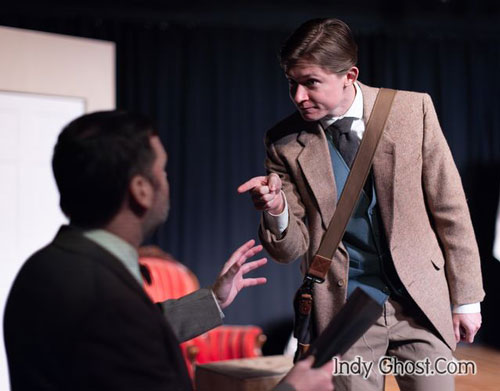By LARRY ADAMS
A Seat on the Aisle
“No, no, you have none of you any idea. This is all nonsense, fantasy, it is not like this. Nothing so blood-curdling and becreepered and crude – not so … so laughable. The truth is quite other, and altogether more terrible.”
“If It bleeds, it leads” has been the perhaps oversimplified mantra of modern journalism, but the same could be said for the horror genre. The quick and easy grab of blood and guts, the more sensational the better, has been a staple of successful franchises such as Friday the 13th, Child’s Play, and Nightmare on Elm Street for the last several decades. And, credit where credit is due, it does sell the popcorn and rake in the bucks before being quickly forgotten and set aside for The Next Big Thing.
Classic horror, on the other hand, the kind that leaves a lasting impression, the kind that makes you flip the lights back on as you lie in bed unable to sleep, tends to be of the less-is-more variety. Show rather than tell, of course, but show only in miserly doses. Mood and tension are the orders of the day. Dread rather than fright, the ultimate goal.
The Hyperion Players of Hamilton County, relative newcomers to the community theater scene, have offered up just such a macabre tale with The Woman in Black, their latest production of the 2024-2025 season, appropriately running this Halloween season, now through Nov. 2 at the Switch Theatre in Fishers. Adapted from a Susan Hill novel by playwright Stephen Mallatratt in 1987, The Woman in Black subsequently became the second longest running play in the West End of London (behind Agatha Christie’s unfathomably long-lived The Mousetrap, of course), but is just now being licensed out into the wider world for local consumption.
The basic plot – man sees a ghost in a creepy house and gradually uncovers its horrifying back story – may seem a bit tired and mundane, but the execution of the storyline makes it fresh and compelling for the audience. Its basic conceit is its theatre setting: Arthur Kipps, a solicitor in early 20th century England, has secured the services of an actor to help him present the decades-old story of his terrifying encounter with the supernatural, thus to purge himself of the awful grip it has held on his life ever since. We the audience are drawn into the tale as we see them rehearse on stage the elements of Arthur’s story – and perhaps a bit more. Props, costumes, and settings are intentionally understated, dark corners abound, past scenes blur into the present as we watch the two labor on the performance. Only one thing – the woman in black – seems disturbingly out of place.
Mallatratt’s script, wordy and intense, would seem a nightmare for a two-person cast to master, but veteran actors David Johnson and Nicholas Gibbs pull off their roles on a par with many a professional I have seen on stage through the years. Johnson in particular does a lot of heavy lifting in the production, portraying a host of different characters, and, although I felt several of them could have used more differentiation in the interests of, well, interest, he handles the job remarkably well.

Nicholas Gibbs as Kipps confronts David Johnson as The Actor in The Hyperion Players’ The Woman in Black. (Photo by Rob Slaven / IndyGhostLight.com)
Both Johnson and Gibbs give workmanlike performances, sure in their dialogue and actions, and exhibiting an easy chemistry together on stage. “Proper, polished and professional,” I jotted down on my program during the second act, though I could have used a bit more “personality” in the mix. Emphasis on humor (when possible and appropriate) and humanity in the portrayals would go a long way; it’s important for the audience to like and feel invested in these characters in order for the horror to have its deepest impact, but by the end I felt I didn’t really care as much about them or their plight as I should. Nor did the characters themselves, it seemed; the final, tragic twist surprisingly barely registered on their faces. I know it’s England – stiff upper lip and all that – but c’mon guys, we Americans need to see some emotion when, you know, people die. Quibbles aside, I always enjoy watching (and stealing from) actors who are better than me, and you can bet I’ll be robbing from these two great performances on stage in the future.
A bit of praise for the uncredited actress playing The Woman (and to director Liz Carrier for not crediting her – despite the slight, The Woman is not credited for a reason, and for the first time ever, I’m sure, I eagerly turned to a cast list hoping NOT to see someone there). To be most effective, The Woman needs to be surreal, almost out of focus or at least out of THE focus, and, except for one episode of thrashing about that I didn’t quite get, this unnamed actress accomplishes that goal. They say there are no small parts, just small actors – here is your perfect illustration.
Although I thought we could have used some more special effects to enhance the mood and suspense (don’t ask me what – I’m not that creative), production values are high here, and on what I suspect is a limited budget. Ms. Carrier keeps the action moving with a steady directorial hand. Zach Caitlin’s sound design is appropriately moody without being distracting. Costumes, and makeup by Bella Lazarides, are also appropriate without being overbearing. These are all aspects of theater that, ironically, have perhaps best been executed when the audience never notices them, and thus are quite often unsung, so I tip my hat to all involved.
And finally, a word of admiration for actor Nicholas Gibbs for managing to pull off – with a straight face – perhaps the worst one-word dialogue choice ever put to the page in the last 70 years (and yes, I’m including the Star Wars prequels). No character not named Stanley Kowalski should EVER have to scream out “Stella!” on stage again.
Read more great play reviews from A Seat on the Aisle at asota.wordpress.com.

